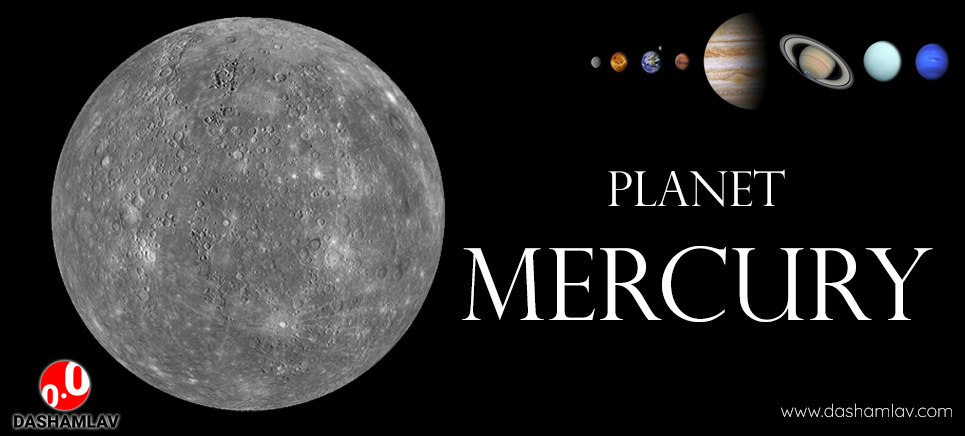Mercury is the planet closest to the Sun. It can bee seen from Earth passing across the face of Sun every seven years. Space missions have studied Mercury and revealed interesting details about this planet which is named after the Roman God — Mercury — the messenger of Gods. Let’s learn some basic facts about the planet Mercury.
- Mercury has highest temperature fluctuation
Day temperature on Mercury can be as high as 450 °C (840 °F) and night temperature can be as low as -170 °C (-275 °F). This constitutes a fluctuation of about 600 °C (1,100 °F) — the highest in the solar system. The reason behind this extreme fluctuation is that Mercury does not have atmosphere necessary to regulate the temperature. - Mercury has been known to humans since ancient times
The earliest known recorded observations of Mercury are on the Mul.Apin tablets from Babylonians of 14th century BC. - Mercury is the second hottest planet in solar system
Although, closest to the Sun, the planet Mercury is not the hottest in the solar system. Counter-intuitively, Venus is the hottest planet. This higher temperature on Venus is because of the greenhouse effect in the atmosphere of Venus. - Only two spacecrafts have visited Mercury so far
NASA’s Mariner 10 was the first spacecraft to visit the smallest planet in the solar system. In 1974-75 the Mariner 10 flew by Mercury three times. MESSENGER, another mission of NASA, visited Mercury in 2008-09. A joint mission of the European Space Agency and the Japanese Space Agency, called BepiColombo, is expected to reach Mercury in 2025. - A year on Mercury is 88 Earth days long
Mercury takes 88 Earth days to complete one orbit around the Sun. Mercury’s orbit is highly eccentric. Consequently, the planet can be 47 million km (29 million miles) to the Sun, and as distant as 70 million km (43 million miles) from the Sun.

- Mercury does not have any natural satellite
Venus is the only other planet, apart from Mercury, which does not have any natural satellite. - Mercury is the second densest planet
Mean density of Mercury is 5.427 gram per cubic centimeter. This is second highest among planets in the solar system. This is because of the fact that Mercury is composed of heavy metals, like iron, and rocks. Only Earth has higher density than Mercury. - There is are no seasons on Mercury
At 0.03°, the axial tilt of Mercury is smallest among the planets of the solar system. Such a negligible tilt means that there are no “seasons” on Mercury. - Core of Mercury is massive
Mercury has an iron core which makes about 40% of its total volume. Earlier it was believed that the core is solid iron, but lately scientists have begun to speculate that the core of Mercury could be made of molten iron. - Mercury’s gravity is only 38% of the Earth
Because of its small size, the gravitational force exerted by Mercury is weak. This is the reason why Mercury has no atmosphere or natural satellite. - Mercury looks like Moon
Mercury’s surface is similar in appearance to that of the Moon. It has lots of craters made by the impact of asteroids and comets.
Statistics about Planet Mercury
| Property | Value |
|---|---|
| Mercury’s radius | 2,439.7 km (0.3829 Earths) |
| Mercury’s surface area | 7.48×107 km2 (0.147 Earths) |
| Mercury’s volume | 6.083×1010 km3 (0.056 Earths) |
| Mercury’s mass | 3.3011 × 1023 kg (0.055 Earths) |
| Mean density | 5.427 g/cm3 |
| Mercury’s average distance from Sun | 57.91 million km (36 million miles) |
| Perihelion (closest approach to the Sun) | 46,001,200 km |
| Aphelion (farthest distance from the Sun) | 69,816,900 km |
| Length of solar day (single rotation on its axis) | 176 Earth days |
| Length of year (single revolution around the Sun) | 99 Earth days |
| Equatorial inclination to orbit (axial tilt) | 0.034 degrees |
| Rotation speed at Equator | 10.892 km/h (3.026 m/s) |
| Surface gravity | 3.7 m/s2 (0.38 g) |
| Escape velocity | 4.25 km/s |
| Natural satellite | Doesn’t have any natural satellite. |
| Mercury’s composition | Atomic Oxygen Sodium Magnesium Atomic Hydrogen Potassium Calcium Helium |
Use the citation below to add this article to your bibliography
"Planet Mercury: Interesting Facts about the Smallest Planet and Closest to Sun." Dashamlav.com. Web. 1 May 2025. <https://dashamlav.com/planet-mercury-interesting-facts-closest-smallest/>
Dashamlav.com, "Planet Mercury: Interesting Facts about the Smallest Planet and Closest to Sun." Accessed 1 May 2025. https://dashamlav.com/planet-mercury-interesting-facts-closest-smallest/
"Planet Mercury: Interesting Facts about the Smallest Planet and Closest to Sun." (n.d.). Dashamlav.com. Retrieved 1 May 2025 from https://dashamlav.com/planet-mercury-interesting-facts-closest-smallest/
